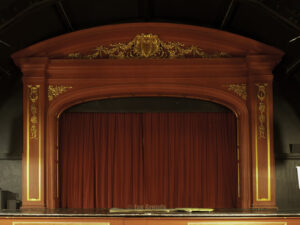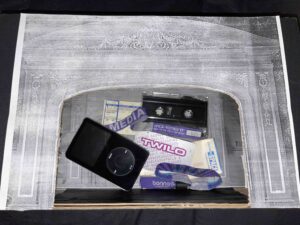George: Cornell Box
I was a little concerned about building a Cornell Box without having a clearer direction on where I wanted to go with my thesis project – but it turned out to be extremely helpful as a broad exploration of my themes of live performance, the ecosystems of performers and audiences, and the way we consume art and entertainment.
Initially it reminded me of the dioramas I made in elementary school, which were essentially three-dimensional models of scenes with cutouts of trees, buildings, cars, etc. – looking back, perhaps they were my first exposure to concepts like tableau and scenic design. Obviously the Cornell boxes aren’t explicit narratives of particular moments in time, but this was a good reference point for me.

The traditional architecture of a theater reflects the principle of a picture frame: the proscenium arch (Fig. 1) borders the stage, and physically distinguishes it from the rest of the room. This becomes the border, the boundary of the “sacred space” where the conventional rules of reality and social interaction don’t apply, if only momentarily. We silently commit our attention, suspend our disbelief, and become witnesses to that moment in time.
We see variations of this arrangement in many other spaces: classrooms, houses of worship, lectures, speeches, sporting events. Even without the physical structures of a proscenium, curtain or stage, we use this framework to make a distinction between the viewer and the participant and their assumed roles in this interaction. In this way, the box becomes as important as what’s in it – a frame separates the canvas from the wall, a pedestal elevates the sculpture it supports – so I decided to use this as an extended metaphor: whatever I put into that box, however grand or banal, is being viewed in a very explicit way simply by virtue of being in that box. The container recontexualizes the object – the medium defines the message.
In light of all this, it almost seems like an afterthought to discuss what’s actually in the box… but here’s a quick breakdown, and some context for each:
- The faded black and white of the proscenium image I used is really a happy accident: I don’t have a color printer and – of course – I’m low on ink. Still, like the impermanence of our memories, the concept of shared experience that I’m exploring is made special precisely because it only lasts temporarily. That’s why we strain to take pictures or video of these events, but nothing ever really captures that moment, does it?
- Ticket stubs – I’m not too precious about saving these for everything I see, but I do save them for memorable shows. It’s nice to have a tangible reminder of these experiences, and I’ve seen some incredible concerts and performances I don’t ever want to forget. These really capture the sense of “electricity” I often refer to when talking about live performance and the energy an audience brings to the “experience” dynamic – even prerecorded media like film and television can evoke that. Watching the “Red Wedding” episode of Game of Thrones, the girl climb out of the tv in “The Ring”, or Chris Rock doing standup are all distinctly different experiences when seen alone versus with an audience.
- Blank cassette – The cassette was arguably the pivotal technology that took music out of the confines of home and anywhere we wanted it – but most importantly, we decided what we wanted to hear, and when. Yes, cars and transistor radios made music portable, but you were limited to what someone else wanted you to hear – and when they saw fit to play it. You had very limited agency in the transaction – the station played a song, and if you didn’t want to hear it, you could tune in to another station and try again. With cassettes, for the first time ever, you could take your favorite band with you – or even customize the songs (and their order!) by recording your own mixtape – no more fast-forwarding or rewinding. And when Sony released the Walkman in the 1980’s, the “personal soundtrack” was born. How we consumed music was never the same again.
- iPod – before smartphones became our all-in-one interfaces for our digital lives, the iPod was the technological bridge that redefined music for the 21st century. Now that music was liberated from its physical medium, we could take our entire collections everywhere we went in an object the size of a pack of cigarettes. Again, customization became a key factor – we could still decide what to hear and when to hear it, but now we weren’t restricted by the limitations in sound quality or capacity of a CD or cassette. Technology gave us more control and again redefined our relationship with the medium and message.
- Twilo membership card – Twilo was a legendary NYC nightclub, and I’d be remiss if I didn’t give special mention to nightlife in particular. I’ve spent plenty of time in clubs, and the DJ/dancefloor dynamic falls squarely into that performer/audience paradigm – but in a far more intense and profound way. The senses are overwhelmed: pitch darkness is punctuated by blinding lights, drum rhythms repeat infinitely, volume is amplified until subsonic frequencies are physically felt in your chest, your abdomen. Yes, to be fair – there are often drugs and intoxicants shaping the experience – but even sober devotees frequently refer to the “spiritual” aspect of this environment. And regardless of the specific music styles being played – disco, techno, house, jungle, trance, EDM – the common thread here is the active participation of the audience through movement. There are parallels to religion, shamanic trance, ecstatic dance rituals, the “purification” of catharsis the ancient Greeks described. The alchemy of music, architecture, lighting, sound, the size of the crowd, the “vibe”, the wait for the bathroom line, even the interaction of checking your coat: any one of these things can make or break a nightclub experience, and classify it as one of the worst nights of your life – or one of the best. This gets to the heart of my theme in a very unique way.
- Festival wristbands – much like ticket stubs, these serve as mementos of particular experiences, but they also speak to the dynamic of a massive audience over a longer period of time: many boast attendance in the hundreds of thousands. Woodstock became a cultural touchstone, due largely to the magnitude of the communal experience, and let’s not even get started on the phenomenon of Burning Man. Most music festivals are destination events in that they require deliberate commitment of time, money and personal sacrifice – often in the form of comfort or privacy – but offer unique opportunities for personal expression that people may not indulge in their everyday lives. The sense of unity (and anonimity?) a mass audience can provide says something about our nature as social creatures, and the loss of communal experiences we’ve felt during COVID has really brought that into focus. There’s simply something transcendent about bringing a group of people together in the same physical space for a shared experience – that’s what I’m trying to get at with all this.
Related Posts
Leave a Reply Cancel reply
You must be logged in to post a comment.
Kat Sullivan
Adam Colestock
Helen (Chenuan) Wu
Christina Lan
Dorian Janezic
George Faya
Julia Myers
Kelsie Smith
Michael Morran
Po-Wen Shih
Liu Siyan
Fisher Yu
—
Craig Protzel
Christopher Wray
Haoqi Xia
Hayden Carey
Katherine Nicoleta Helén
Maria Maciak
Parisa Shemshaki
Sakar Pudasaini
Skyler Pierce
Steven Doughty
Yiqi Wang
—
Andrew Lazarow
Benoit Belsot
Enrique García Alcalá
Hongyi Zhang
Jay Mollica
Li Shu
Teddy (Jian) Guo
Monika Lin
Wenye Xie
Yiru Lu

